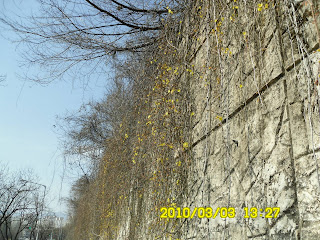March 20 (Sat), Cloudy, occasionally small rain, very strong wind around noon. This is my 14th hike for this year, and my 194th hike with AhToSan.

[Before boarding the ferry、フェリー乗船前に페리 승선전에]
The destination is SaRangDo. SaRangDo consists of 8 islands; 3 habited islands and 5 uninhabited islets. SaRangDo locates in the middle of Hallyo Maritime National Park, in the south east part of Korea Peninsula.

[Map of SaRangDo, 蛇梁島の地図、사량도 지도]
Among these islands, there are a set of two big islands, each called Sangdo (Upper island) and Hado (Lower island.) I climbed ChilHongBong with AhToSan people just 2 years ago (08/3/15). This time, we headed for JiriMangSan – BulMoSan – OkNyoBong in Sangdo.
The weather was not favorable for us since a powerful low pressure was passing the peninsula from west to east. The rain all day, and strong wind/high turf were predicted in the previous day.
So AhToSan prepared an alternative hiking to MiReukSan (461m) in Tongyeong city in case of no ferry service.

[AhToSan stuff members prepared two maps, just in case、アトサンは万一に備え2枚の地図を用意した。아토산은 만일에 대비하여 지도 2장을 준비했다.]
Fortunately the real weather was not so bad as predicted. It was not raining when we left Daejeon and when we arrived at a part near Tongyeong, the wind was not too strong.
The ferry boat company decided to operate the boats, but just in case, AhToSan decided to make the whole trip short by abandoning JiriMangSan.
“Mang” means “view” and JiriMangSan means a mountain from where you can view the famous Mt. Jiri (1915m) in Jeollado Province. It was cloudy and foggy day, so there is no use to climb that mountain.
BulMoSan (400m) and OkNyoBong (261m) are rocky mountains, and it must be fun, just for climbing rocks and cliffs.

[A rocky ridge to OkNyoBong、玉女峰への稜線、옥녀붕의 능선]
This time, two of my Stammtisch* friends joined this hiking; H is the owner of the restaurant where Stammtisch people meet. T is an English teacher who comes from Australia. There are not necessary strong hikers. Therefore it was a bit hard hike for them.
(Stammtisch is a casual English meeting place where anyone who want to speak English and exchange ideas in English can join. They regularly meet at a restaurant called "Pasta House" near KAIST every Wednesday evening.)
When we arrived at Naeji Port in Upper Island, it was still 10 a.m. We went through Naeji Village to the entrance of the steep trail. Naeji Village however is very unique and beautiful village. Wall of each house and concrete fences are all painted with colorful pictures and poems. They are fantastic!

[Pictures and poems on the wall in the village, 村の家々の壁には童話のような絵と詩が描かれていた。마을 집집의 벽에는 동화와 같은 그림과 시가 그려져 있었다.]
But we hurried to BulMoSan because we were informed that the ferry shall leave the port at 2 p.m. The first part of this hiking was difficult for my friends, because it was steep, and only up and up slope. They were the last two among 40 hikers.
We had early lunch on the ride of BulMoSan at 11: a.m. Then the wind was really strong and even a little rain began to fall. The mountain was covered with deep fog, and I was afraid of any accident. Be had lunch in the woods, so we could avoid the strong wind.

[Early lunch in the woods, 林の中で早い昼食、 숲 속에서 이른 점심]
When we began walking along the ridge, the strong wind stopped, and we could relatively easy to walk forward.
There are several steep parts of the trail, but such cases, there is an alternative trail for beginners. So 3 of us chose easier course, and arrived the fork of trails; one leads to GaMaBong (303m) and OkNyoBong (with another rock climbing) and the other leads to descend to the port.

[AhToSam members climbing up using the ropes, ロープを使って崖を登るアトサン会員、로프를 사용해서 벼랑을 오르는 아토회원들]
I recommended H and T to go down, not going to GaMaBong/OkNyoBong and they followed my advice. There was another guy who also chose this easy course.
So, four of us went down from the fork to the port.
When we looked up to the mountain, we could see AhToSan people climbing up to the steep ridge. We enjoyed talking and the nature while going down to the beach.

[AhToSan members climbing up the mountain, 濃霧の中、登山を続けるアトサン会員たち、농무 속 등산을 계속하는 아토 회원들]
We saw several groups of Jindalle flowers and blossoms of plum trees and etc., the sign of springs.

["Jindalle" or Korean azalea were in full bloom, 麓ではチンダルレが咲いていた。기슭에서는 진달래가 피어 있었다.]
We arrived at the port at 12:30 and had to kill time for one and half hours. The rest of hikers arrived at the port just in time at 2 p.m.
By this time, there was almost no wind, and weather became much better. There was a beautiful cruise ship in the harbor and a maritime police ship. When hikers arrived at the port, they enjoyed taking photos with such scenes.

[A cruiser ship at anchor, クルーザーが停泊していた。 크루즈가 정박하고 있었다.]
We returned to the port in Tongyeong, and had “after the hike” party with spicy soup called “Bude Jige” and some special wine called “Gugija” wine. We enjoyed the food and drinks very much. We came back to Daejeon at 7 p.m.
2010年3月20日(土)曇り、一時強風と小雨、今年14回目、アトサン194回目の登山。
今月に入って連続して島登山シリーズの第3弾として慶南・統営市の「蛇梁島(サリャンド)」を目指した。蛇梁島は韓国南部の閑麗(ハルリョ)海上国立公園中心部に位置し、3つの有人島と5つの無人島からなる島嶼群を言う。
このうち大きな島は上島と下島といい、向かい合っている。アトサンは2年前の2008年3月15日に、下島の七賢山(348m)に登っている。
今回は当初、上島の智異望山~仏母山~カマ峰~玉女峰の縦走コースを登る予定だったが、前夜からこの日の午後にかけて低気圧が半島を横断し、そのため全国的に雨と、強風が予想された。
最悪の場合、フェリーが欠航することも予想され、アトサン運営チームはその場合に備えて代替登山として統営の「弥勒山(461m)」も準備していた。

[In side of the ferry boat, フェリーの内部、페리 내부]
しかし、幸いなことに、暴風波浪注意報は発令されず、フェリーは運航した。ただし、曇天の濃霧で、目玉の智異望山へ登っても智異山は望めないことが明らかで、全体の登山を短縮し、仏母山(400m)~カマ峰(303m)~玉女峰(261m)だけを登山することにした。
今回は水曜日の英語サロン「スタムティッシュ」からパストハウスの女主人であるHとオーストラリア人のTが参加した。
また、大田印刷人山岳会の中年男性9名がまとまって参加したこともあり、全体ではほぼ満員の40人の参加となった。
バスはエキスポ南門駐車場を3週間連続で6時に出発。途中2回ほど休憩して統営のサンジョクアム(상족암)遊覧船乗り場に9時20分に到着した。当初10時出発の予定だったが、予定を早め9時40分には出港し、10時には上島の内地港(내지항)に着いた。船は小型でアトサン40名借り切りだった。
内地港の漁村は家や塀の壁にきれいな童話のような絵と詩が描かれている。どうも内地マウル(村)は童詩マウルとして有名らしい。登山時間が限られていて、この村の写真をゆくり撮れなかったが、それでも後で見てもきれいだ。

[Pictures and poems on the wall in the village, 村の家々の壁には童話のような絵と詩が描かれていた。마을 집집의 벽에는 동화와 같은 그림과 시가 그려져 있었다.]
この村を過ぎるとすぐにガレ沢の直登で、山登りに慣れた会員とそうでない会員との差がすぐに出た。スタムティッシュのHとTは当然最後尾で、それもかなり離されてしまった。この登りは勾配もきつくて足場も悪く、湿度と温度が高かったためすぐ汗だくになった。
それでも1時間ほど登りきると尾根にでた。尾根に出ると強風注意報の予報がぴったりのものすごい強風でしかも小雨まじり。これから岩場が大変と思った頃、尾根の林の中で早くも昼食をとった。

[Strong wind on the ridge, 尾根は強風、능선이는 강풍이 불고 있었다.]
昼食後、幸いなことに小雨と風は止み、岩場はなんとか切り抜けた。仏母山は石標がわからず通過し、尾根伝いに1時間ほど進むと、カマ峰/玉女峰へ至る道と、テハン(대항)船着き場へ下る道との分かれ目に来た。

[At the fork, 分かれ道にて 갈림길에서]
私は、HとTには岩登りが続くカマ峰/玉女峰は無理と判断し、テハン方面へ下る方を選んだ。同行したのはニックネームが「ハハ」という50代の男性だけで、他は全員がロープや80度近い階段のあるカマ峰/玉女峰方面を選んだ。

[OkNyoBong appears as the fog getting cleared、霧が晴れて玉女峰が姿を現してきた。안개가 개서 옥여봉이 모습을 나타내 왔다.]
下りの道を慎重に下って行くと天気は次第に回復し、港に出た時はもう風はほとんどなく、凪のような状態だった。
港近くの丘にはチンダルレの群落がいっせいに咲き誇り、梅の花も満開だった。

帰りの船は2時に出港のはずだったが、結局2時半ごろにずれ、それでも3時前には半島側の港に着いた。

[Return ferry was larger than going ferry, 帰りのフェリーは大型だった。귀로의 페리는 대형이었다.]
駐車したバスの横で恒例のティップリのメニューは「部隊チゲ」と呼ばれるチゲ料理と薬酒とされる「枸杞子(クギジャ)」酒のごちそうだった。

[Tipurri Menu: Bude Soup & GuGiJa(Chinese matrimony vine) wine, ティップリは部隊チゲと枸杞子酒]、됫풀이는 부대찌개와 구기자주]























































